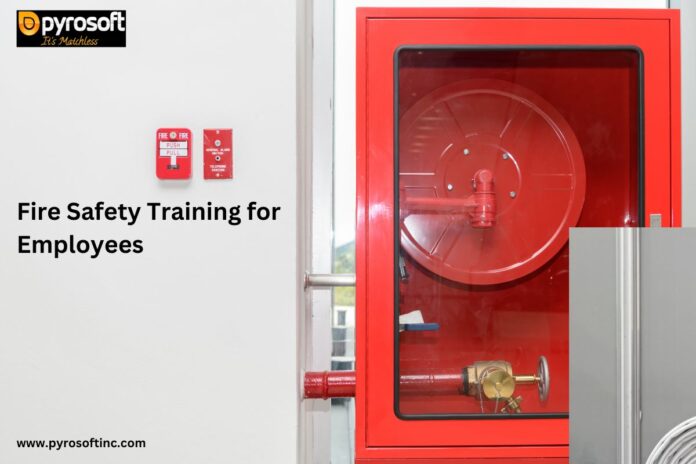In any workplace, safety should always be a concern. Among the different hazards that employees may encounter, fires are one of the most serious. Fires at an office building, a manufacturing plant, or a retail store can cause significant property damage, injuries, and even fatalities. However, with comprehensive fire safety training, personnel can be provided with the knowledge and skills needed to prevent fires, respond efficiently in an emergency, and reduce possible damage. In this blog, we’ll look at the significance of fire safety training for employees and discuss some critical features of good training programs.
Understanding the Importance of Fire Safety Training
Fire safety training is more than just a legal necessity; it is a critical investment in personnel safety and asset protection. Here are some of the reasons why fire safety training is essential in the workplace.
1. Risk Awareness: Many employees may not completely understand the fire threats in their jobs or the implications of a fire. Fire safety training promotes knowledge of potential fire dangers such as electrical faults, poor combustible material storage, and culinary hazards, among others.
2. Emergency Preparedness: In the event of a fire, every second matters. Proper training ensures that personnel understand how to respond quickly and effectively. This involves understanding evacuation procedures, finding fire escapes, using fire extinguishers, and supporting people’s needs.
3. Reducing Panic: Panic may amplify the chaos of a fire emergency, causing injuries and impeding evacuation efforts. Employees acquire confidence in their capacity to deal with emergencies calmly, which reduces the chance of panic.
4. Protecting Lives and Property: The ultimate purpose of fire safety training is to save lives while minimizing property damage. Well-prepared employees can take proper actions to contain small fires, safely evacuate, and allow emergency responders to arrive more quickly.
Key Components of Fire Safety Training Programs
An efficient fire safety training program should cover a wide range of topics to ensure complete readiness. These are some essential components to include:
1. Fire Prevention Techniques: Prevention is the primary line of protection against fire. Employee training should cover topics such as adequate flammable material storage, frequent electrical equipment maintenance, and safe use of heating appliances.
2. Identifying Fire Hazards: Employees should be able to identify potential fire dangers in their workplace and report them promptly. Training should emphasize frequent occupational hazards and suggest mitigation strategies.
3. Emergency Response Procedures: Clear and short evacuation procedures are essential for a safe exit in the case of a fire. Employees should get training on evacuation routes, assembly points, and protocols for aiding those with disabilities.
4. Fire Extinguisher Training: While fleeing the building is the top priority during a fire, there may be times when the use of fire extinguishers is required to put out small fires. Employees should be given hands-on training in selecting the right type of extinguisher and utilizing it properly.
5. Role-specific Training: Different roles within an organization may require particular training depending on their responsibilities during a fire emergency. For example, dedicated fire wardens or safety officials may be given additional training in leadership and evacuation coordination.
6. Regular Drills and Refreshers: Fire safety training should not be a one-time experience. Regular drills and refresher workshops are critical for reinforcing information, testing emergency procedures, and identifying opportunities for improvement.
Implementing Fire Safety Training for Employees
When adopting fire safety training programs, organizations should prioritize accessibility, relevance, and efficacy. Below are several approaches to effectively implement fire safety training programs:
1. Tailored Training: Customize training programs to meet the unique needs and dangers of the workplace. Consider aspects such as industry type, facility layout, and workforce demographics.
2. Engagement and Participation: Make training sessions interactive and interesting to increase learning retention. Encourage active engagement with group discussions, practical activities, and scenario-based simulations.
3. Multimedia Resources: Multimedia resources including movies, animations, and online sections can be used to supplement traditional training approaches. Employees can access training materials at their own pace, and key concepts are reinforced visually.
4. Feedback and Evaluation: Solicit feedback from employees after training sessions to determine their understanding and areas for improvement. Regularly evaluate emergency response methods using drills and simulations.
5. Continuous Improvement: Fire safety methods change, for that reason, it’s critical to stay current on the latest rules, technologies, and best practices. Incorporate lessons learned from real-life occurrences and modify training sessions accordingly.
Conclusion
Fire safety training is an essential component of workplace safety, enabling personnel to prevent fires, respond effectively in emergencies, and protect lives and property. Employers may foster a culture of safety and preparation for everybody by investing in thorough training programs suited to the organization’s specific needs. Remember, when it comes to fire safety, education is the most powerful instrument for avoiding disaster.




















